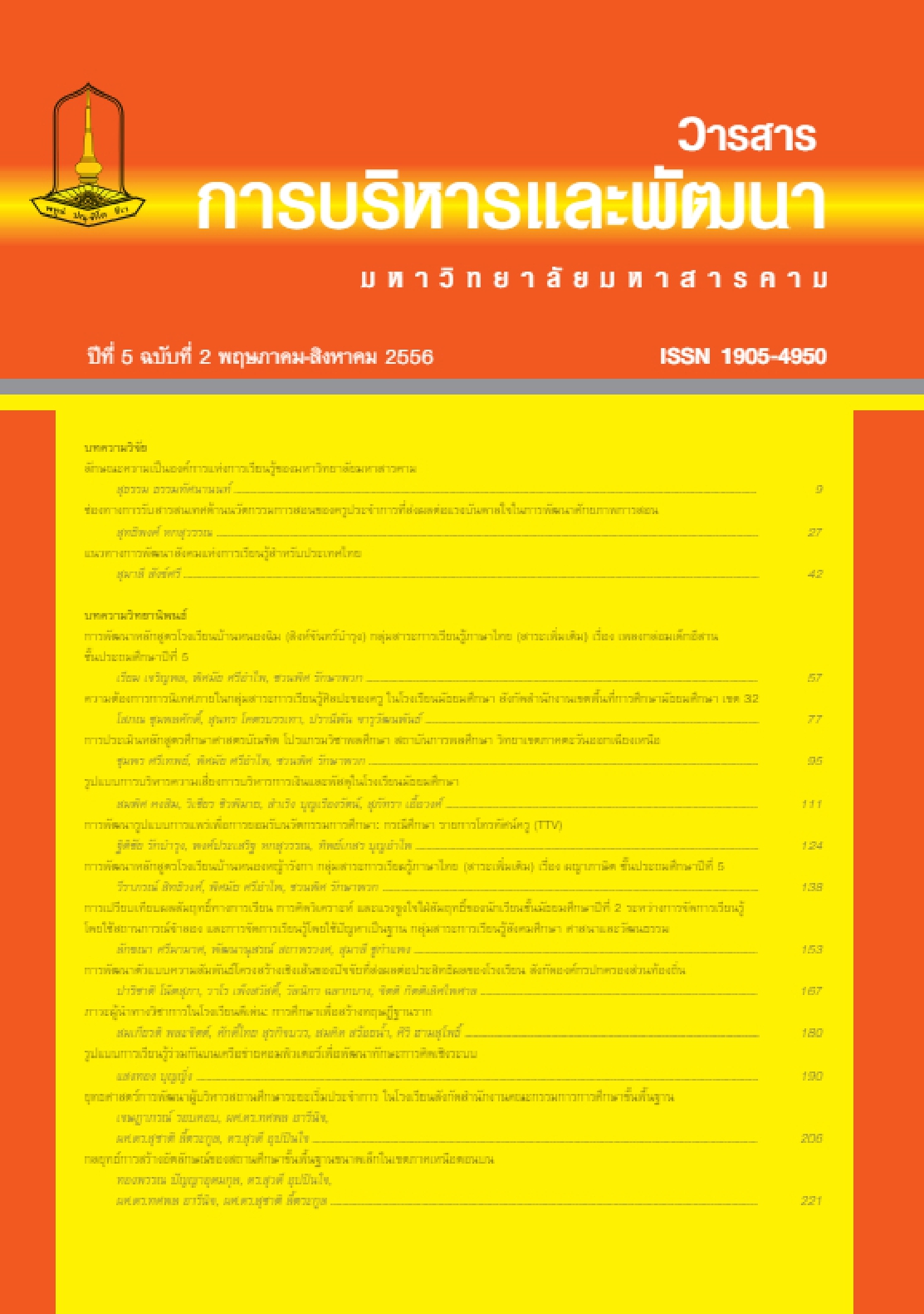THE DEVELOPMENT OF DIFFUSION FOR ADOPTION MODEL ON EDUCATIONAL INNOVATION: CASE STUDY OF TEACHER’S TV PROGRAM (TTV)
Main Article Content
Abstract
The purposes of this research were: 1) To develop the diffusion for adoption model on educational innovation: case study of Teacher’s TV Program (TTV), 2) To evaluate and certify the diffusion for adoption model on educational innovation: case study of Teacher’s TV Program (TTV) by the specialists. The methods of this research were: 1) Review of literatures and researches by the content analysis method, 2) Analysis the diffusion system of Teacher’s TV Program (TTV) in the present, 3) Analysis the diffusion of Teacher’s TV Program (TTV) by using the questionnaire for quantitative data, using in-depth interview and focus group for the qualitative data, 4) Develop draft of the diffusion for adoption model on educational innovation: case study of Teacher’s TV Program (TTV), 5) Criticisms and debate the diffusion for adoption model on educational innovation: case study of Teacher’s TV Program (TTV) by the experts, 6) Each chairmen in the board of Teacher’s TV Program (TTV) confirm and comment on the diffusion for adoption model on educational innovation: case study of Teacher’s TV Program (TTV) and improved model from the result, 7) Evaluate and certify the diffusion for adoption model on educational innovation: case study
of Teacher’s TV Program (TTV) by the specialists. The samples were: 1) An amount of 2,368 for the quantitative data and an amount of 303 for qualitative data from the executives, teachers, students and parent, around Thailand, 2) The sample 10 experts in innovation and educational technology or the involved fields for focus group, 3) The sample 6 chairmen in the board of Teacher’s TV Program (TTV) for confirm and comment on the diffusion for adoption model on educational innovation: case study of Teacher’s TV Program (TTV) and 4) The sample 5 specialists in innovation and educational technology or the involved fields for Evaluate and certify the diffusion for adoption model on educational innovation: case study of Teacher’s TV Program (TTV).The instruments used in this research were: 1) The questionnaires about the adopter categories, behavior to watch, comment and needs of Teacher’s TV Program (TTV), 2) The structure of In-depth interview for executives and the questions of focus group for teachers, students and parent 3) The open-ended questionnaire for the expert, 4) the diffusion for adoption model on educational innovation: case study of Teacher’s TV Program (TTV), 5) The questionnaires about confirmation the model, and 6) The evaluate and certify forms.
The research results reveal that: 1) The diffusion for adoption model on educational innovation: case study of Teacher’s TV Program (TTV) are composed by (1) Philosophy, vision, mission and the objectives, (2) The process of communicate to knowledge about Teacher’s TV Program, (3) The process of communicate to advantage Teacher’s TV Program, (4) The process of communicate to except decision Teacher’s TV Program, (5) The process of communicate to implementation Teacher’s TV Program, (3) The process of communicate to confirmation Teacher’s TV Program 2) The chairmen confirm diffusion for adoption model on educational innovation: case study of Teacher’s TV Program (TTV) at “much appropriate”. 3) The specialists certify the diffusion for adoption model on educational innovation: case study of Teacher’s TV Program (TTV) at “much
appropriate”.
Downloads
Article Details
References
Faculty of Education Burapha University. (2010). The development of TV program for teacher development Project: Analysis of Policy, Content, Design, Preparation for Television Programs, Development and Production of Media Content Under the development plan for education “Strong Thailand Action Plan (B.E. 2553-2555)”. Chonburi: Faculty of Education Burapha University.
Havighurst, R. (1972). Human Development and Education. 3rd ed. New York: Longmans.
Jongruk Jangyubol. (2002). A Study on Level and Factors of Social Studies Teachers Acceptance of Instructional Innovations at Secondary School Level, Bangkok Metropolis. Master Degree in Teaching Social Studies Department of Secondary Education. Bangkok: Faculty of Education Chulalongkorn University.
Kotler, P., Brown, L., Adam, S., and Armstrong, G. (2004). Marketing. 6th ed. Sydney: Pearson Education Australia.
Lungsana Boonnimit. (1999). The Relationships Among Roles of Parents, Teachers and Peers in Supporting English Learning Achievement of Mathayom Suksa Three Students in Schools under the Department of General Education, Bangkok Metropolis. Master in Teaching English as a Foreign Language Department of Secondary School. Bankok: Faculty of Education Chulalongkorn University.
Office of the Education Council . (2011). Education Reform Policy in the Second Decade (B.E. 2552-2561). Bangkok: Ministry of Education.
Porter, L. W., & Lawler, E. E. (1968). Managerial Attitudes and Performance. Homewood, IL: Richard D. Irwin, Inc.
Rogers M Everettm. (2003). Diffusion of Innovations. 5Th ed.NewYork: Free Press A Division of Simon & Schuster, Inc.
Schramm W. (1973). Channels and Audience in Handbook of Communication. Chicago: R.Mcnally College Publishing Company.
Sumlee Thongthew. (2002). Diffusion of Educational innovations for Administrators and Teachers in the Education Reform. Bangkok: Chulalongkorn University
Printing House. Surapong Sotanasathien. (1990). Communication and Social. Bangkok: Chulalongkorn University Printing House.
Suwimon and Others. (2012). Analysis of School’s Education Development Process after the First Round of External Evaluation. Document for the national conference “The quality of Education for Thailand”. Bangkok: Research Affairs Faculty of Education Chulalongkorn University.


